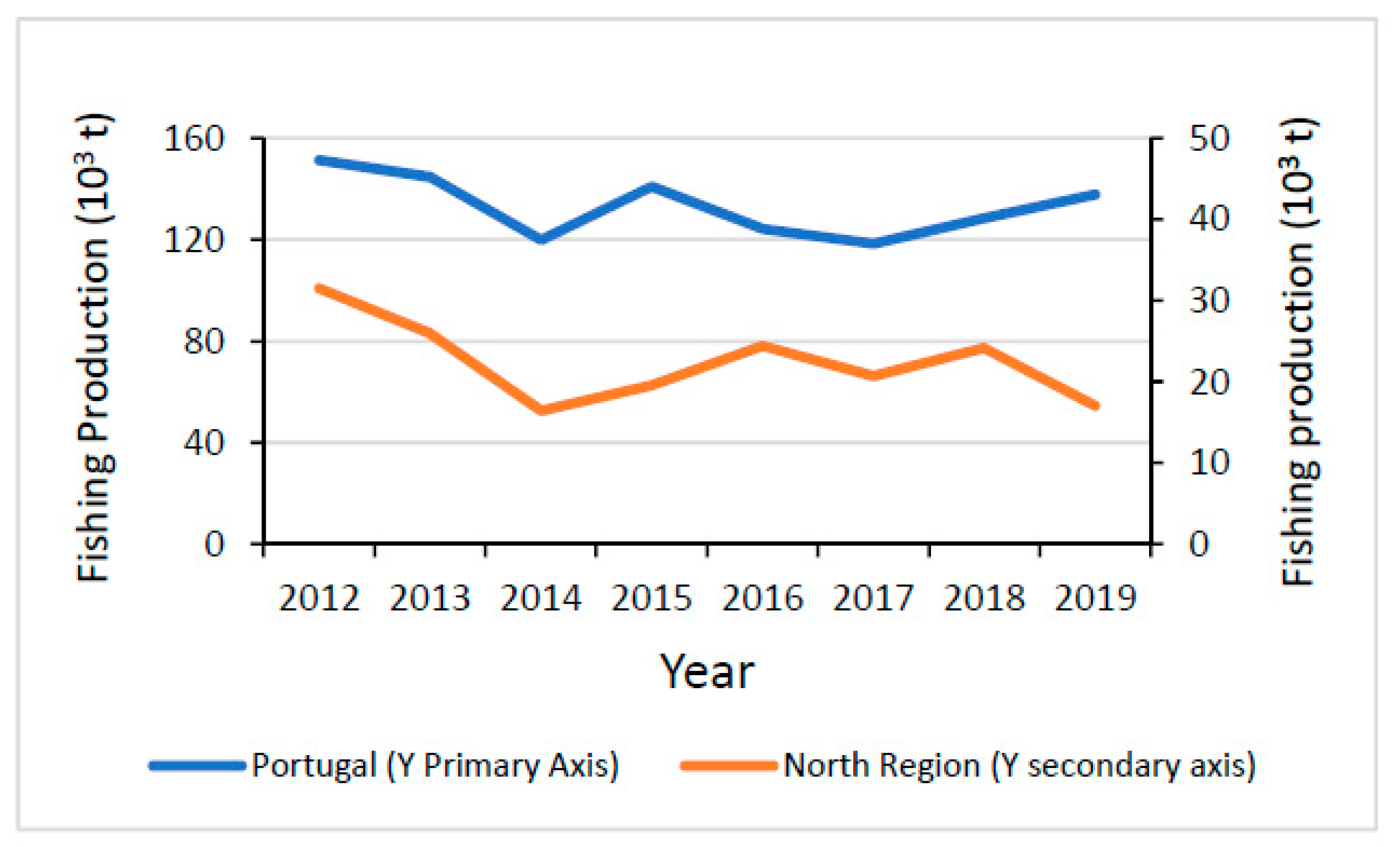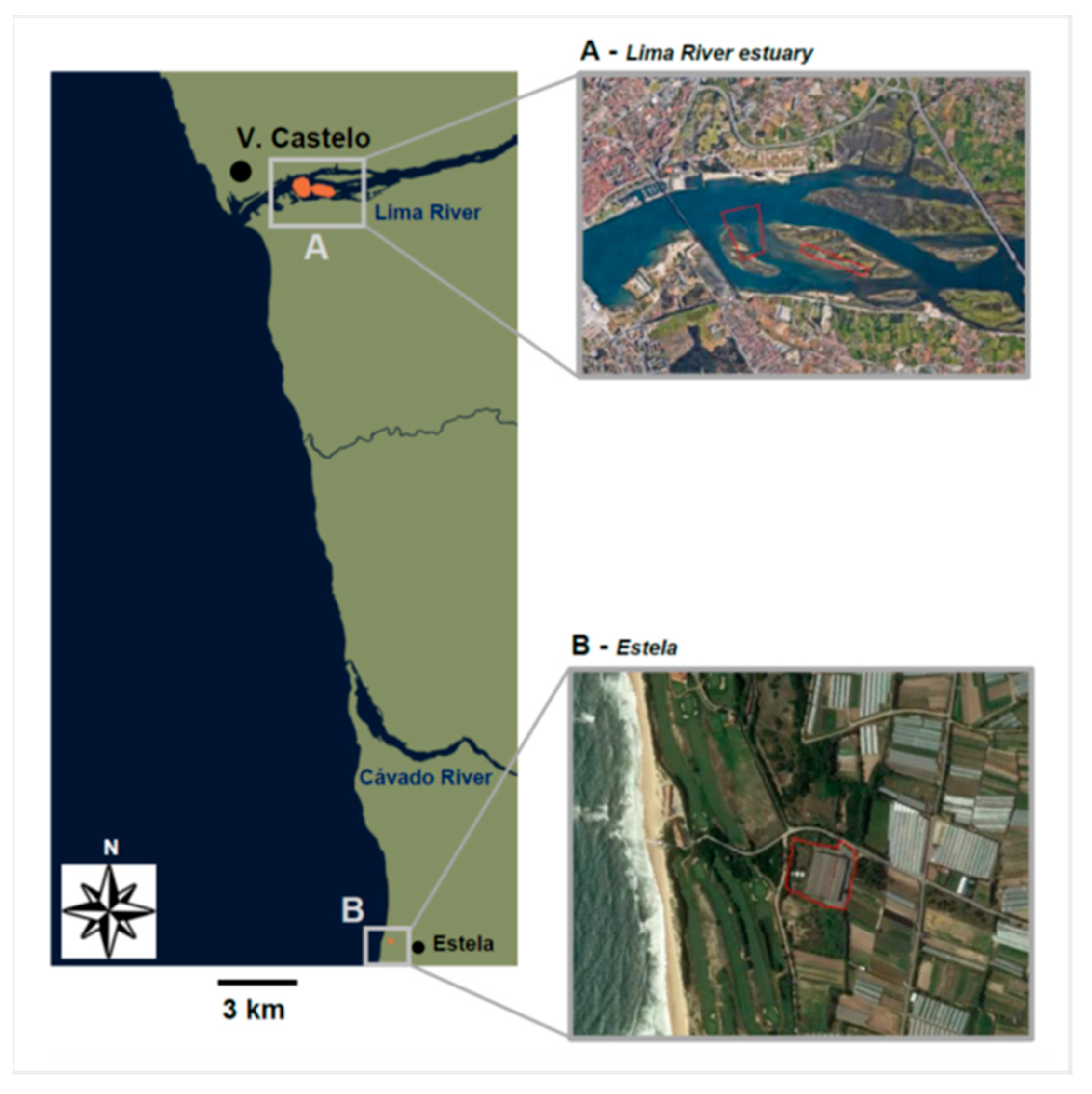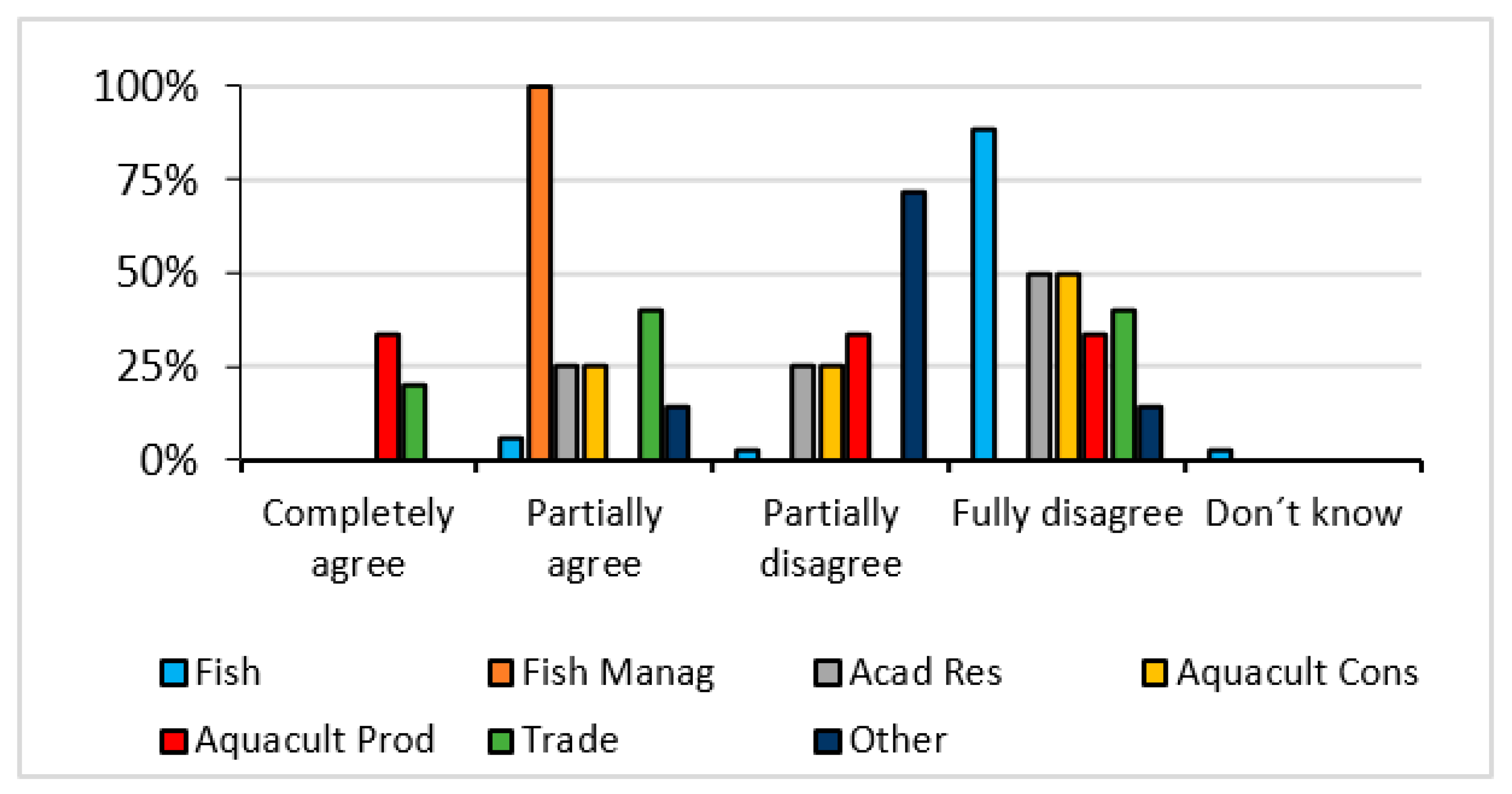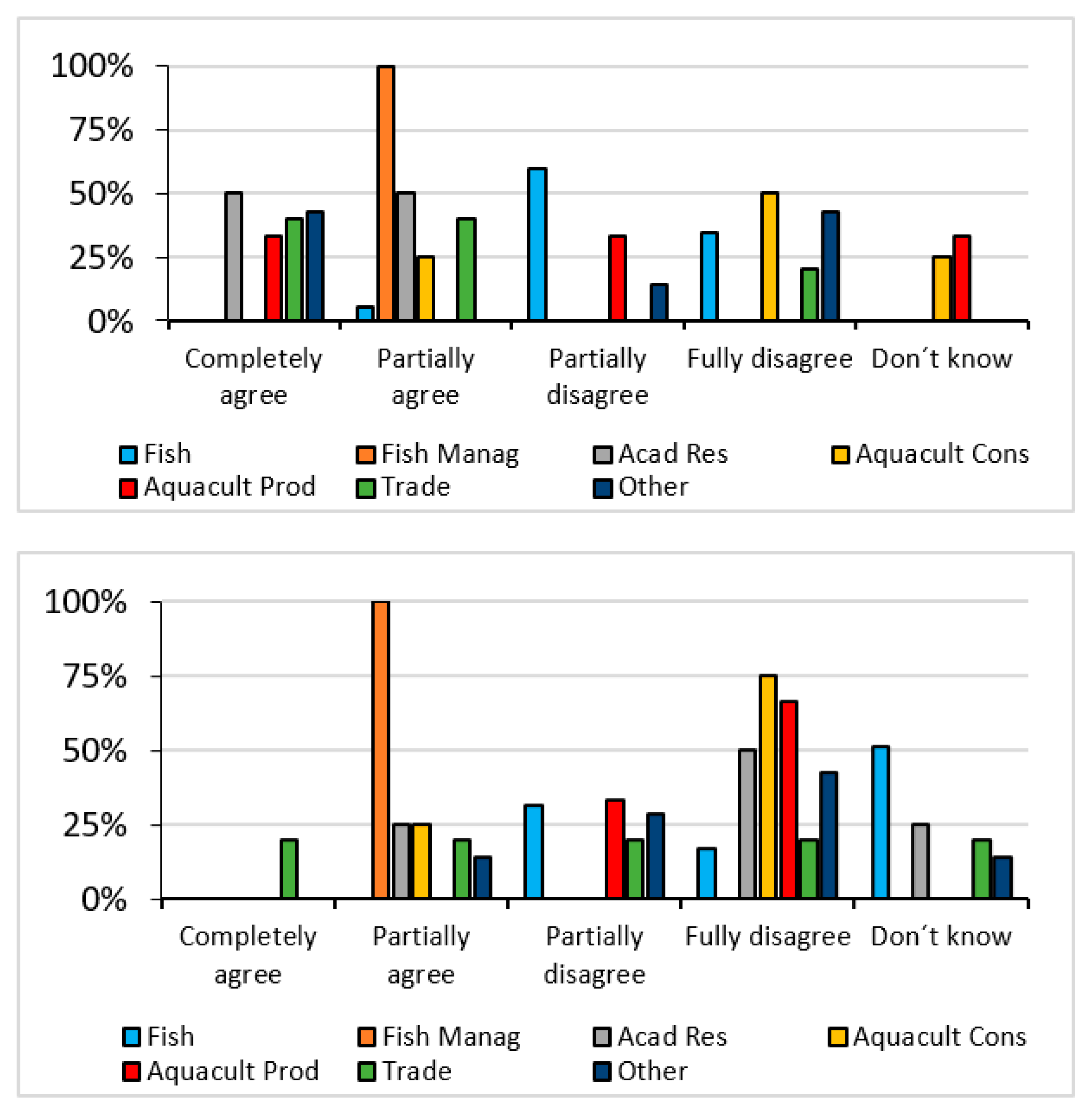Sustainable Fishing and Aquaculture Activities in the Atlantic Coast of the Portuguese North Region: Multi-Stakeholder Views as a Tool for Maritime Spatial Planning
Abstract
1. Introduction
2. Material and Methods
2.1. Description of Case Study
2.2. Official Information Sources
2.3. Multi-Stakeholder ECOAST Survey
2.4. Multi-Stakeholder Regional Workshop
3. Results
3.1. Portuguese Official Policies and Legal Framework
3.2. Current Context of Regional Fishing and Aquaculture Activities
3.3. Multi-Stakeholder ECOAST Survey
4. Discussion
4.1. The Portuguese MSP and Potential Conflicts between Activities
4.2. Sustainability and Growth of Fishing and Aquaculture Activities
5. Conclusions
Author Contributions
Funding
Institutional Review Board Statement
Informed Consent Statement
Data Availability Statement
Acknowledgments
Conflicts of Interest
Abbreviations
| APA | Aquaculture production area |
| CFP | Common Fisheries Policy |
| EU | European Union |
| MSP | Maritime spatial planning |
| NOS | National Ocean Strategy |
| RAS | Recirculating aquaculture system |
References
- Douvere, F. The importance of marine spatial planning in advancing ecosystem-based sea use management. Mar. Policy 2008, 32, 762–771. [Google Scholar] [CrossRef]
- European Commission. Strategic Guidelines for the Sustainable Development of EU Aquaculture. European Commission, Communication from the Commission to the European Parliament, the Council, the European Economic and Social Committee and the Committee of the Regions; European Commission: Brussels, Belgium, 2013; 12p. [Google Scholar]
- European Commission. Report on the Blue Growth Strategy. Towards More Sustainable Growth and Jobs in the Blue Economy; European Commission, Commission Staff Working Document; European Commission: Brussels, Belgium, 2017; 61p. [Google Scholar]
- Charles, H.; Godfray, J.; Beddington, J.R.; Crute, I.R.; Haddad, L.; Lawrence, D.; Muir, J.F.; Pretty, J.; Robinson, S.; Thomas, S.M.; et al. Food security: The challenge of feeding 9 billion people. Science 2010, 327, 812–818. [Google Scholar]
- Béné, C.; Barange, M.; Subasinghe, R.; Pinstrup-Andersen, P.; Merino, G.; Gro-Ingunn, H.; Williams, M. Feeding 9 billion by 2050—Putting fish back on the menu. Food Sec. 2015, 7, 261–274. [Google Scholar] [CrossRef]
- FAO. The State of World Fisheries and Aquaculture 2018—Meeting the Sustainable Development Goals; FAO: Rome, Italy, 2018; 227p. [Google Scholar]
- Jay, S. Planners to the rescue: Spatial planning facilitating the development of off-shore wind energy. Mar. Pollut. Bull. 2010, 60, 493–499. [Google Scholar] [CrossRef] [PubMed]
- Gentry, R.R.; Froehlich, H.E.; Grimm, D.; Kareiva, P.; Parke, M.; Rust, M.; Gaines, S.D.; Halpern, B.S. Mapping the global potential for marine aquaculture. Nat. Ecol. Evol. 2017, 1, 1317–1324. [Google Scholar] [CrossRef] [PubMed]
- Lester, S.E.; Stevens, J.M.; Gentry, R.R.; Kappel, C.V.; Bell, T.W.; Costello, C.J.; Gaines, S.D.; Kiefer, D.A.; Maue, C.C.; Rensel, J.E.; et al. Marine spatial planning makes room for offshore aquaculture in crowded coastal waters. Nat. Commun. 2018, 9, 945. [Google Scholar] [CrossRef] [PubMed]
- Gilliland, P.M.; Laffoley, D. Key elements and steps in the process of developing ecosystem-based marine spatial planning. Mar. Policy 2008, 32, 787–796. [Google Scholar] [CrossRef]
- Ehler, C.; Douvere, F. Marine Spatial Planning: A Step-by-Step Approach toward Ecosystem-Based Management. Intergovernmental Oceanographic Commission (IOC) and the Man and the Biosphere Programme (MAB); IOC Manual; UNESCO: Paris, France, 2009; pp. 1–98. [Google Scholar]
- Olsen, E.; Fluharty, D.; Hoel, A.H.; Hostens, K.; Maes, F.; Pecceu, E. Integration at the round table: Marine spatial planning in multi-stakeholder settings. PLoS ONE 2014, 9, e109964. [Google Scholar] [CrossRef]
- Bacher, K.; Gordoa, A.; Mikkelsen, E. Stakeholders’ perceptions of marine fish farming in Catalonia (Spain): A Q-methodology approach. Aquaculture 2014, 424–425, 78–85. [Google Scholar] [CrossRef]
- Keijser, X.; Ripken, M.; Mayer, I.; Warmelink, H.; Abspoel, L.; Fairgrieve, R.; Paris, C. Stakeholder engagement in maritime spatial planning: The efficacy of a serious game approach. Water 2018, 10, 724. [Google Scholar] [CrossRef]
- Corner, R.A.; Aguilar-Manjarrez, J.; Massa, F.; Fezzardi, D. Multi-stakeholder perspectives on spatial planning processes for mariculture in the Mediterranean and Black Sea. Rev. Aquacult. 2019, 12, 1–18. [Google Scholar] [CrossRef]
- Tiller, R.; Richards, R.; Salgado, H.; Strand, H.; Moe, E.; Ellis, J. Assessing stakeholder adaptive capacity to salmon aquaculture in Norway. Cons. J. Sustain. Dev. 2014, 11, 62–96. [Google Scholar]
- DGPM. Direção Geral de Política do Mar. National Ocean Strategy 2013–2020; Uzina Books: Lisbon, Portugal, 2014. [Google Scholar]
- DGRM. Direção Geral de Recursos Naturais, Segurança e Serviços Marítimos. Plano Estratégico para a Aquicultura Portuguesa 2014–2020; DGRM: Lisbon, Portugal, 2013; 89p. Available online: https://www.dgrm.mm.gov.pt/ (accessed on 6 January 2021).
- DGRM. Direção Geral de Recursos Naturais, Segurança e Serviços Marítimos. Plano de Situação. Espacialização de Servidões, Usos e Atividades. 2018, Volume III-A. Available online: https://www.psoem.pt/ (accessed on 6 January 2021).
- DGRM. Direção Geral de Recursos Naturais, Segurança e Serviços Marítimos. Plano para a Aquicultura em Águas de Transição. 2019; 161p. Available online: https://www.dgrm.mm.gov.pt/ (accessed on 6 January 2021).
- INE-DGRM. Instituto Nacional de Estatística—Direção Geral de Recursos Naturais, Segurança e Serviços Marítimos. Estatísticas da Pesca, EP, 2019. 2020. Available online: https://www.ine.pt/ (accessed on 6 January 2021).
- INE-DGRM, Instituto Nacional de Estatística—Direção Geral de Recursos Naturais, Segurança e Serviços Marítimos. Estatísticas da Pesca, EP, 2012. 2013. Available online: https://www.ine.pt/ (accessed on 6 January 2021).
- ICES, International Council for the Exploration of the Sea. Workshop on the Iberian Sardine Management and Recovery Plan (WKSARMP); ICES Scientific Reports; ICES: Copenhagen, Denmark, 2019; Volume 1, 168p. [Google Scholar]
- Pomeroy, R.; Douvere, F. The engagement of stakeholders in the marine spatial planning process. Mar. Policy 2008, 32, 816–822. [Google Scholar] [CrossRef]
- Forester, J. The Deliberative Practitioner: Encouraging Participatory Planning Processes; MIT Press: Cambridge, MA, USA, 2008; 322p. [Google Scholar]
- Smith, G.; Jentoft, S. Marine spatial planning in Scotland. Levelling the playing field? Mar. Policy 2017, 84, 33–41. [Google Scholar] [CrossRef]
- Flannery, W.; Healy, N.; Luna, M. Exclusion and non-participatory in Marine Spatial Planning. Mar. Policy 2018, 88, 32–40. [Google Scholar] [CrossRef]
- INE-DGRM, Instituto Nacional de Estatística—Direção Geral de Recursos Naturais, Segurança e Serviços Marítimos. Estatísticas da Pesca, EP, 2014. 2015. Available online: https://www.ine.pt/ (accessed on 6 January 2021).
- INE-DGRM, Instituto Nacional de Estatística—Direção Geral de Recursos Naturais, Segurança e Serviços Marítimos. Estatísticas da Pesca, EP, 2015. 2016. Available online: https://www.ine.pt/ (accessed on 6 January 2021).
- European Commission. Addressing Conflicting Spatial Demands in MSP. Considerations for MSP Planners; Final Technical Study; European Commission: Brussels, Belgium, 2019; 35p. [Google Scholar]
- Cameron, E.; Green, M. Making Sense of Change Management. A Complete Guide to the Models, Tools and Techniques of Organizational Change, 5th ed.; Kogan Page: London, UK, 2012; 544p. [Google Scholar]
- Eayrs, S.; Cadrin, S.X.; Glass, C.W. Managing change in fisheries: A missing key to fishery-dependent data collection? ICES J. Mar. Sci. 2015, 72, 1152–1158. [Google Scholar] [CrossRef]
- Cashion, T.; Al-Abdulrazzak, D.; Belhabib, D.; Derrick, B.; Divovich, E.; Moutopoulos, D.K.; Noël, S.-L.; Palomares, M.L.D.; Teh, L.C.L.; Zeller, D.; et al. Reconstructing global marine fishing gear use: Catches and landed values by gear type and sector. Fish Res. 2018, 206, 57–64. [Google Scholar] [CrossRef]
- Coelho, C.; Silva, R.; Veloso-Gomes, F.; Taveira-Pinto, F. Potential effects of climate change on northwest Portuguese coastal zones. ICES J. Mar. Sci. 2009, 66, 1497–1507. [Google Scholar] [CrossRef]
- TEN-SHORES. Meeting for Dissemination of Results Achieved in the TEN-SHORES Project. 19th July 2016. Santander (Spain). 2016. Available online: http://www.ten-shores.ihcantabria.es (accessed on 6 January 2021).
- Ozório, R.O.A.; Rato, A.; Valido, L.; Joaquim, S.; Machado, J.; Matias, A.M.; Gonçalves, J.F.; Vaz-Pires, P.; Matias, D. Effects of Ulva rigida as microalgae diet replacement on broodstock conditioning, gonadal maturation and spawning success of the Pacific oysters (Crassostrea gigas). J. Mar. Biol. Ocean 2018, 7, 21. [Google Scholar]
- Cardoso, C.; Gomes, R.; Rato, A.; Joaquim, S.; Machado, J.; Gonçalves, J.F.; Vaz-Pires, P.; Magnoni, L.; Matias, D.; Coelho, I.; et al. Elemental composition and bioaccessibility of farmed oysters (Crassostrea gigas) fed different ratios of dietary seaweed and microalgae during broodstock conditioning. Food Sci. Nutr. 2019, 7, 2495–2504. [Google Scholar] [CrossRef]
- Rato, A.; Pereira, L.F.; Joaquim, S.; Gomes, R.; Afonso, C.; Cardoso, C.; Machado, J.; Gonçalves, J.F.; Vaz-Pires, P.; Magnoni, L.J.; et al. Fatty acid profile of Pacific oyster, Crassotrea gigas, fed different ratios of dietary seaweed and microalgae during broodstock conditioning. Lipids 2019, 54, 531–542. [Google Scholar] [CrossRef] [PubMed]
- Morais, S.; Aragão, C.; Cabrita, E.; Conceição, L.E.C.; Constenla, M.; Costas, B.; Dias, J.; Duncan, N.; Engrola, S.; Estevez, A.; et al. New developments and biological insights into the farming of Solea senegalensis reinforcing its aquaculture potential. Rev. Aquacult. 2014, 8, 227–263. [Google Scholar] [CrossRef]
- Borges, P.; Medale, F.; Dias, J.; Valente, L.M.P. Protein utilisation and intermediary metabolism of Senegalese sole (Solea senegalensis) as a function of protein:lipid ratio. Br. J. Nutr. 2013, 109, 1373–1381. [Google Scholar] [CrossRef] [PubMed]
- Salas-Leiton, E.; Conde-Sieira, M.; Pelusio, N.; Marques, A.; Maia, M.R.G.; Soengas, J.L.; Valente, L.M.P. Dietary protein/carbohydrate ratio in low-lipid diets for Senegalese sole (Solea senegalensis, Kaup 1858) juveniles. Influence on growth performance, nutrient utilization and flesh quality. Aquacult. Nutr. 2018, 24, 131–142. [Google Scholar] [CrossRef]
- Baião, L.F.; Rocha, F.; Costa, M.; Sá, T.; Oliveira, A.; Maia, M.R.G.; Fonseca, A.J.M.; Pintado, M.; Valente, L.M.P. Effect of protein and lipid levels in diets for adult sea urchin Paracentrotus lividus (Lamarck, 1816). Aquaculture 2019, 506, 127–138. [Google Scholar] [CrossRef]










| Document | Type | Year | |
|---|---|---|---|
| 1 | National Oceanic Strategy 2013–2020 (NOS 2013–2020) | Official policy | 2014 |
| 2 | Law n. 17/2014, from 10 April, establishing the Basis of the Policy | Legislation | 2014 |
| for Planning and Management of National Sea Area | |||
| 3 | Strategic Plan for Portuguese Aquaculture 2014–2020 | Official policy | 2015 |
| 4 | Decree-law n. 38/2015, from 12 March, developing the law of Basis | Legislation | 2015 |
| of the Policy for Planning and Management of National Sea Area | |||
| 5 | Decree-law n. 139/2015, from 30 July, modifying the Decree-law n. 38/2015, | Legislation | 2015 |
| from 12 March | |||
| 6 | Order n. 11494/2015, from 14 October, referring to the authorities with | Legislation | 2015 |
| responsibility for the elaboration the Maritime Spatial Plan of the National Maritime Area. | |||
| 7 | Order n. 1608/2018, from 13 February 2018, referring to elaboration | Legislation | 2018 |
| of Aquaculture Map for Transition Waters | |||
| 8 | Resolution of Council of Ministers n. 203-A/2019, from 30 December 2019, | Legislation | 2019 |
| referring to the approval of the Maritime Spatial Plan for continental Portugal, | |||
| Madeira and extended continental platform | |||
| Intervention Area | Objective |
|---|---|
| Administration | To establish a complete and updated legal frame that defines the actions focused on an adequate organization and use of the Portuguese maritime area |
| To build a maritime spatial plan that identifies potential areas for each maritime activity, minimizing impacts and favoring synergies | |
| To simplify the bureaucratic-administrative procedures required for the achievement of licenses to operate in sea areas (by making a unified digital platform available) | |
| Fishing industry | To promote structural and organizational changes, i.e., a sector mainly constituted of small companies (vessels under 12 m and 1–2 workers) must advance towards producer ssociations and cooperatives, with an enhanced environmental focus and a greater potential to innovate and adopt technology |
| To valorize fish as a primary product by adding value to captures, where new alternative methods of conservation, transformation and diversification, along with the achievement of a Portuguese-origin product certificate (in terms of quality and sustainability) and the foreign investment attraction, constitute key strategies | |
| Aquaculture industry | To adopt structural and organizational changes allowing the current business network (large number of small family companies with limited management and innovation abilities) to evolve towards a higher degree of professionalization |
| To identify areas potentially adequate for aquaculture by information gathering and planning, considering the off-shore modality and aquaculture in transition waters (with special attention to disused or degraded wetlands) as key targets | |
| To increase, diversify (in terms of species and products), and valorize the national aquaculture offer, assuming sustainability, quality and food safety as main ruling principles | |
| Research on fisheries | To achieve a greater knowledge on the status, evolution, and sustainability of main fish stocks |
| To develop new fishing practices in order to meet standards based on technological efficiency, capture selection, and reduction of fish discard | |
| To study in detail the wild ecosystems hosting valuable fish species | |
| Research on aquaculture | To increase the knowledge regarding genetic selection of breeders, pathology control, nutritional and feeding parameters optimization, and improvement of environmental footprint |
| To transform base research into valuable “know-how” useful for the aquaculture sector |
Publisher’s Note: MDPI stays neutral with regard to jurisdictional claims in published maps and institutional affiliations. |
© 2021 by the authors. Licensee MDPI, Basel, Switzerland. This article is an open access article distributed under the terms and conditions of the Creative Commons Attribution (CC BY) license (http://creativecommons.org/licenses/by/4.0/).
Share and Cite
Salas-Leiton, E.; Vieira, L.R.; Guilhermino, L. Sustainable Fishing and Aquaculture Activities in the Atlantic Coast of the Portuguese North Region: Multi-Stakeholder Views as a Tool for Maritime Spatial Planning. Sustainability 2021, 13, 663. https://doi.org/10.3390/su13020663
Salas-Leiton E, Vieira LR, Guilhermino L. Sustainable Fishing and Aquaculture Activities in the Atlantic Coast of the Portuguese North Region: Multi-Stakeholder Views as a Tool for Maritime Spatial Planning. Sustainability. 2021; 13(2):663. https://doi.org/10.3390/su13020663
Chicago/Turabian StyleSalas-Leiton, Emilio, Luis R. Vieira, and Lúcia Guilhermino. 2021. "Sustainable Fishing and Aquaculture Activities in the Atlantic Coast of the Portuguese North Region: Multi-Stakeholder Views as a Tool for Maritime Spatial Planning" Sustainability 13, no. 2: 663. https://doi.org/10.3390/su13020663
APA StyleSalas-Leiton, E., Vieira, L. R., & Guilhermino, L. (2021). Sustainable Fishing and Aquaculture Activities in the Atlantic Coast of the Portuguese North Region: Multi-Stakeholder Views as a Tool for Maritime Spatial Planning. Sustainability, 13(2), 663. https://doi.org/10.3390/su13020663





